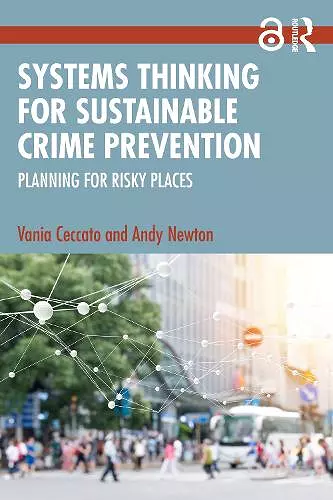Systems Thinking for Sustainable Crime Prevention
Planning for Risky Places
Andy Newton author Vania Ceccato author
Format:Paperback
Publisher:Taylor & Francis Ltd
Published:7th Nov '24
Should be back in stock very soon

This book offers a comprehensive overview of areas with elevated levels of crime, which we consider ‘risky places.’ These can be facilities, nodes, or paths and can be found everywhere, from small towns to megacities. Crime and fear are examined from the perspective of those who use these places, based on examples from the US, the UK, Sweden, Nigeria, Brazil, China, Australia, and more. Advocating for a systems thinking approach, the book shows what can be learned from risky places and identifies ways to address their inherent problems. The book also assesses current barriers to applying systems thinking and identifies ways to foster interconnected long-term crime prevention strategies that meet the diverse needs of multiple stakeholders. Aimed at academics, students, and professionals in urban planning, criminology, geography, and related fields, this book is a vital resource for those dedicated to creating safer, more inclusive, and sustainable environments.
The Open Access version of this book, available at http://www.taylorfrancis.com, has been made available under a Creative Commons Attribution (CC-BY) 4.0 license.
"This book provides an important advancement in sustainable crime prevention in risky places. The authors ask the reader to look at risky places within the context of the surrounding complex systems that make up the local, regional and larger areas as well as the actors that shape what occurs. Each chapter in the book is of great value but, as a whole, it brings criminologists, geographers, psychologists, urban planners, architects, sociologists and government officials closer together in advancing safety and reducing risk."
Patricia Brantingham, Professor of Computational Criminology, Simon Fraser University, Canada
"Through a systems thinking approach, the authors explore the interconnected nature of risky places and the socio-spatial contexts in which they are located to understand the challenges and opportunities for more appropriate intervention. They offer new ways to analyze the complex dynamics giving rise to crime in specific areas and propose a framework for applying systems thinking to study and intervene in risky places. The book offers a valuable lens and tool towards safer and more sustainable human settlements."
Karina Landman, Professor, Department of Town and Regional Planning, University of Pretoria, South Africa
"Through their wide-ranging and stimulating treatment of risky places, the two internationally leading authors of this book show why it is now necessary and appropriate to build a systems perspective onto two well-established approaches to safety and security. Situational crime prevention first emerged as a successful field of research and practice by isolating itself from traditional criminological domains of societal structure and offender motivation. CPTED (Crime Prevention Through Environmental Design) arose as a school of practice within architecture. The authors show how to treat situations and built environments both urban and rural via a wider and deeper systems-level analysis. Systems thinking promises to guide understanding, intervention, practical implementation, and evaluation in this complex domain involving many diverse stakeholders at various geographical scales. It also enables us to merge security goals creatively and rigorously with those of sustainability and other beneficial outcomes."
Paul Ekblom, Emeritus Professor, Design Against Crime Research Lab, Central Saint Martins, University of the Arts London; Visiting Professor, Department of Security & Crime Science, University College London and Applied Criminology & Policing Centre, University of Huddersfield, United Kingdom
ISBN: 9781032249865
Dimensions: unknown
Weight: 470g
238 pages